AMD's Richland vs. Intel's Haswell GPU on the Desktop: Radeon HD 8670D vs. Intel HD 4600
by Anand Lal Shimpi on June 6, 2013 12:00 PM ESTMetro: Last Light
Metro: Last Light is the latest entry in the Metro series of post-apocalyptic shooters by developer 4A Games. Like its processor, Last Light is a game that sets a high bar for visual quality, and at its highest settings an equally high bar for system requirements thanks to its advanced lighting system. This doesn’t preclude it from running on iGPUs thanks to the fact that it scales down rather well, but it does mean that we have to run at fairly low resolutions to get a playable framerate.
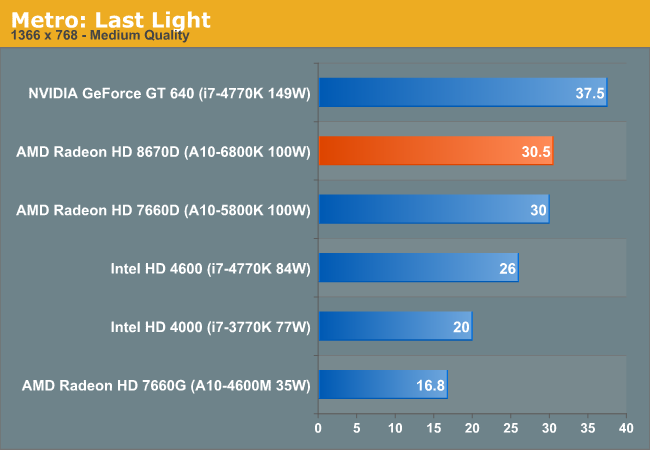
Looking at desktop parts alone, Intel really suffers from not having a socketed GT3 SKU. Although HD 4600 is appreciably faster than HD 4000 (+30%), both Trinity and Richland are around 17% faster than it. As you'll see, Metro ends up being one of the smaller gaps between the two in our suite.
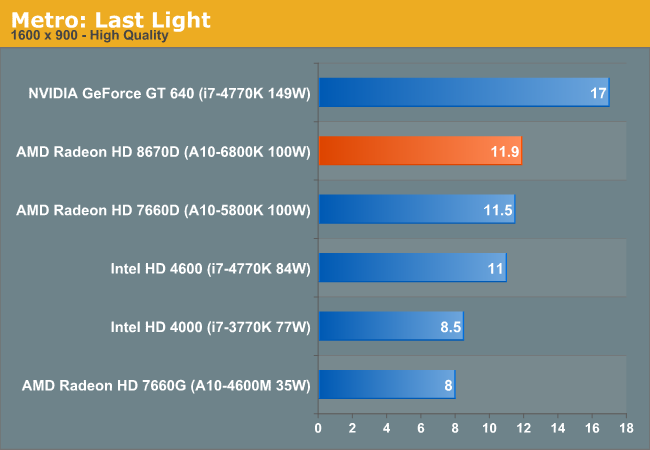
As memory bandwidth becomes the ultimate bounding condition, the gap between Richland and Haswell shrinks considerably. Note that on the HD 4600 side, the difference between DDR3-1333 and DDR3-2400 is only 10% here. Given the limited performance of the 20 EU Haswell GPU configuration, it doesn't seem like Intel is all that bandwidth limited here.
BioShock: Infinite
Bioshock Infinite is Irrational Games’ latest entry in the Bioshock franchise. Though it’s based on Unreal Engine 3 – making it our obligatory UE3 game – Irrational had added a number of effects that make the game rather GPU-intensive on its highest settings. As an added bonus it includes a built-in benchmark composed of several scenes, a rarity for UE3 engine games, so we can easily get a good representation of what Bioshock’s performance is like.
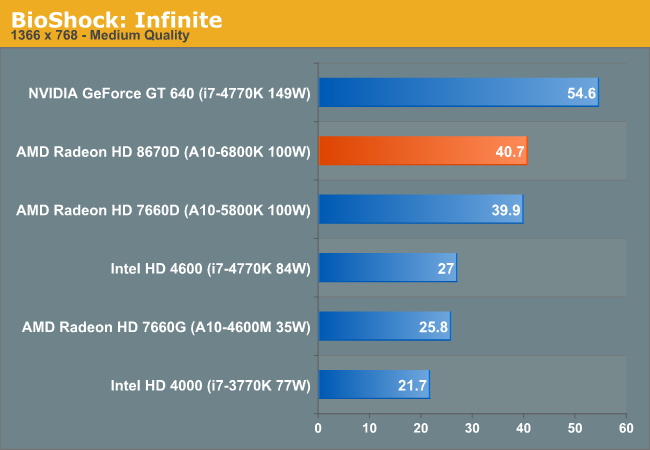
If Metro was an example of the worst case scenario for Richland, BioShock: Infinite is the best case scenario. Here the Radeon HD 8670D holds a 50% performance advantage over Intel's HD 4600 graphics.
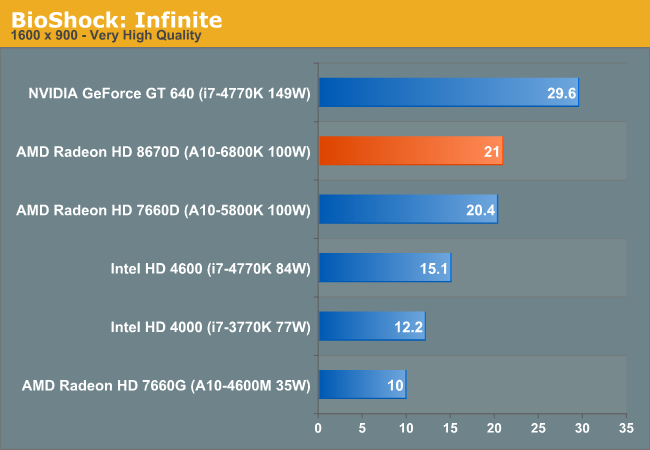
The gap narrows a bit at higher resolution/quality settings, but it's still 39%.
Sleeping Dogs
A Square Enix game, Sleeping Dogs is one of the few open world games to be released with any kind of benchmark, giving us a unique opportunity to benchmark an open world game. Like most console ports, Sleeping Dogs’ base assets are not extremely demanding, but it makes up for it with its interesting anti-aliasing implementation, a mix of FXAA and SSAA that at its highest settings does an impeccable job of removing jaggies. However by effectively rendering the game world multiple times over, it can also require a very powerful video card to drive these high AA modes.
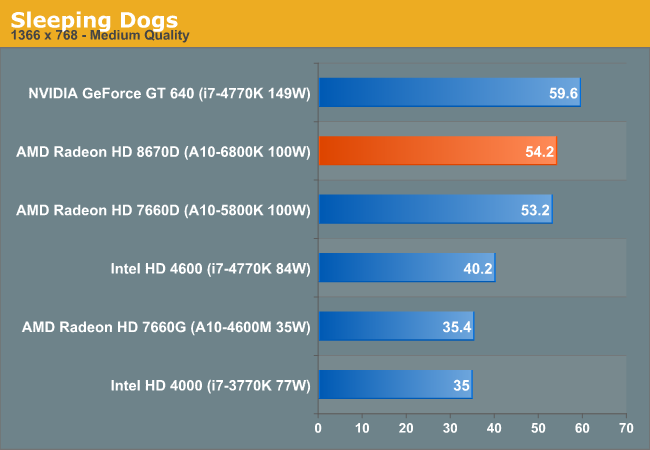
Richland is approaching 60 fps in our Sleeping Dogs benchmark at medium quality, definitely not bad at all. The advantage over Intel's HD 4600 is 34%.
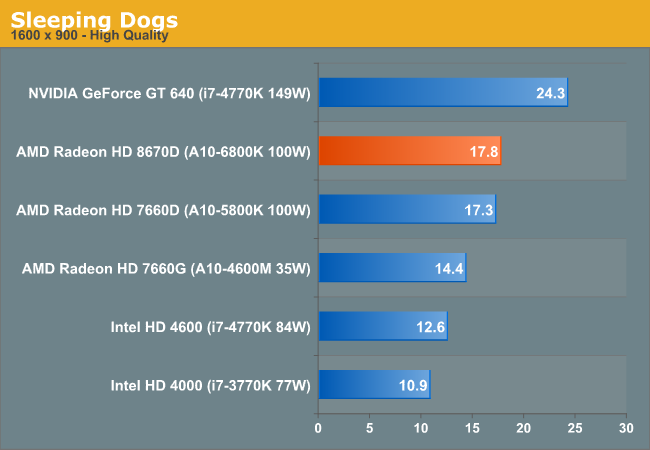
The performance advantage grows a bit at the higher quality/resolution settings, however we drop below the line of playability. With most of these games, you can trade off image quality for resolution however.
Tomb Raider (2013)
The simply titled Tomb Raider is the latest entry in the Tomb Raider franchise, making a clean break from past titles in plot, gameplay, and technology. Tomb Raider games have traditionally been technical marvels and the 2013 iteration is no different. iGPUs aren’t going to have quite enough power to use its marquee feature – DirectCompute accelerated hair physics (TressFX) – however even without it the game still looks quite good at its lower settings, while providing a challenge for our iGPUs.

Tomb Raider is another title that doesn't put Richland in the best light, but it still ends up around 23% faster than Haswell GT2.
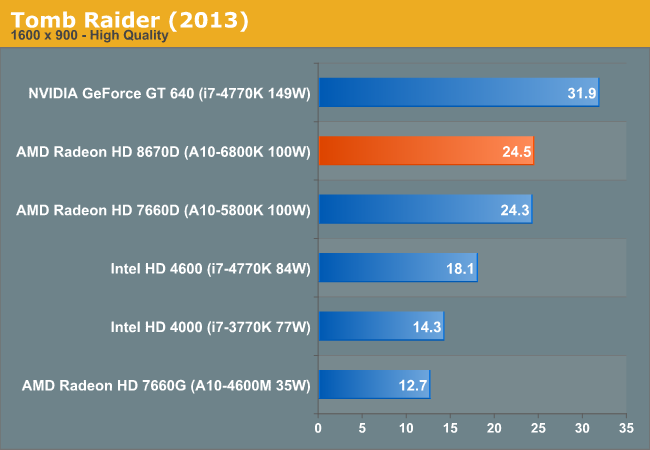
Battlefield 3
Our multiplayer action game benchmark of choice is Battlefield 3, DICE’s 2011 multiplayer military shooter. Its ability to pose a significant challenge to GPUs has been dulled some by time and drivers at the high-end, but it’s still a challenge for more entry-level GPUs such as the iGPUs found on Intel and AMD's latest parts. Our goal here is to crack 60fps in our benchmark, as our rule of thumb based on experience is that multiplayer framerates in intense firefights will bottom out at roughly half our benchmark average, so hitting medium-high framerates here is not necessarily high enough.
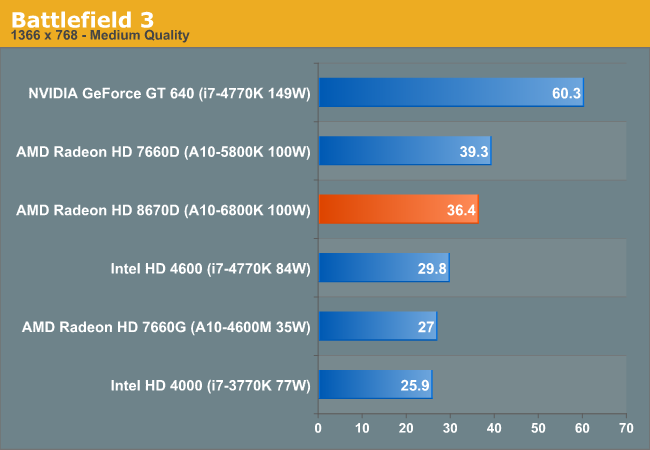
Richland's performance in Battlefield 3 climbs around 30% over the HD 4600 regardless of quality/resolution.

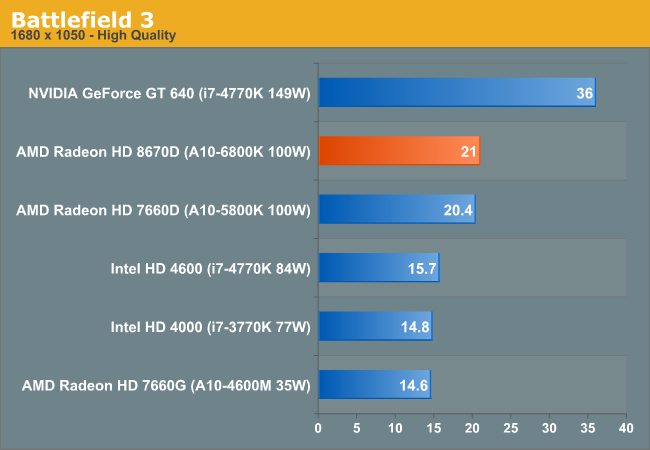
Crysis 3
With Crysis 3, Crytek has gone back to trying to kill computers, taking back the “most punishing game” title in our benchmark suite. Only in a handful of setups can we even run Crysis 3 at its highest (Very High) settings, and the situation isn't too much better for entry-level GPUs at its lowest quality setting. In any case Crysis 1 was an excellent template for the kind of performance required to drive games for the next few years, and Crysis 3 looks to be much the same for 2013.

Crysis is another benchmark where we see an increase in performance in the low 30% range.
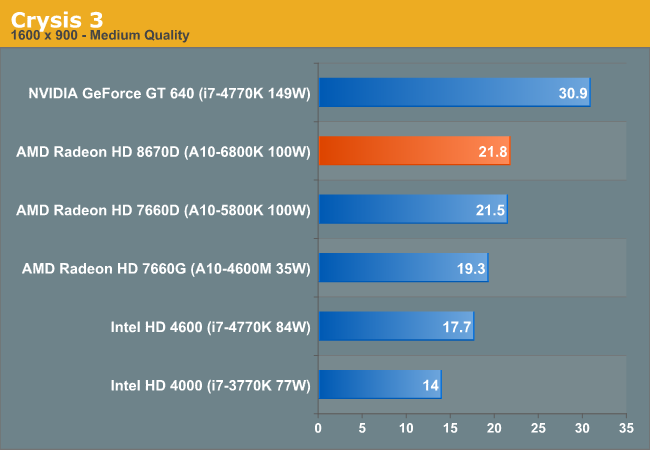











102 Comments
View All Comments
BSMonitor - Thursday, June 6, 2013 - link
No, the comparison is absolutely meaningless. You are saying that someone's decision to buy a Core i7 4770 is influenced by the iGPU. It is not.Ortanon - Thursday, June 6, 2013 - link
The comparison isn't for people buying Core i7 lol. You wouldn't need a comparison if you were already going to buy it. The comparison is exactly what it says: Radeon HD 8670D vs. Intel HD 4600.BSMonitor - Thursday, June 6, 2013 - link
That's what I said. He is saying the price between the two should also matter. And as you say, people buying a Core i7 are not comparing iGPUs.BSMonitor - Thursday, June 6, 2013 - link
The comparison in question is not the article... It's the price comparison, go back to the beginning of the thread.silverblue - Thursday, June 6, 2013 - link
Unless you're very much interested in QuickSync, that is.jjj - Thursday, June 6, 2013 - link
1080p monitors can be found even bellow 100$ ,there isn't really a point in reviewing desktop anything bellow 1080p. going lower to find where a game becomes playeble is fine but the review should have 1080p tests even if the products are not good enough.Would be nice if Kaveri would double the SP count but AMD might be going for a smaller die to cut costs given their difficult financial situation. Wouldn't quite match the Xbox in perf but would be close enough and could do a decent job at playing console ports for the next few years.
DigitalFreak - Thursday, June 6, 2013 - link
Why test at a resolution where you're not going to get playable frame rates? If you can only get playable frame rates @ 768p by running medium quality, I'm pretty sure it's going to be unplayable at anything other than low / minimum @ 1080p.jjj - Thursday, June 6, 2013 - link
that's one of the points ,"you are pretty sure" not sure because the review doesn't do it's job to show you for sure and if you want a clear picture you need to look elsewhere.Death666Angel - Thursday, June 6, 2013 - link
Considering that nothing here is playable at 900p, it is quite possible to extrapolate that 1080p won't be playable either. So I'm pretty fine with them not testing it. If you get a $150 APU to play the latest games at 1080p (a resolution much larger than current consoles support in gaming, might I add), you are deluded.britjh22 - Thursday, June 6, 2013 - link
Are the tests currently set up to show higher res but lower detail settings? I know there is a set benchmark settings that they use to normalize, which is fine for high end CPU/mid to high end GPU testing. If I remember correctly the setting, as they climb in "quality" (low, medium, high) increase both resolution and detail concurrently. With Trinity/Richland and eventually Kaveri, it would be interesting to see if these APU's can handle recent games at higher resolution, but lower detail settings. Essentially can you get any recent games to play at common resolutions, even if you have to crank down settings.